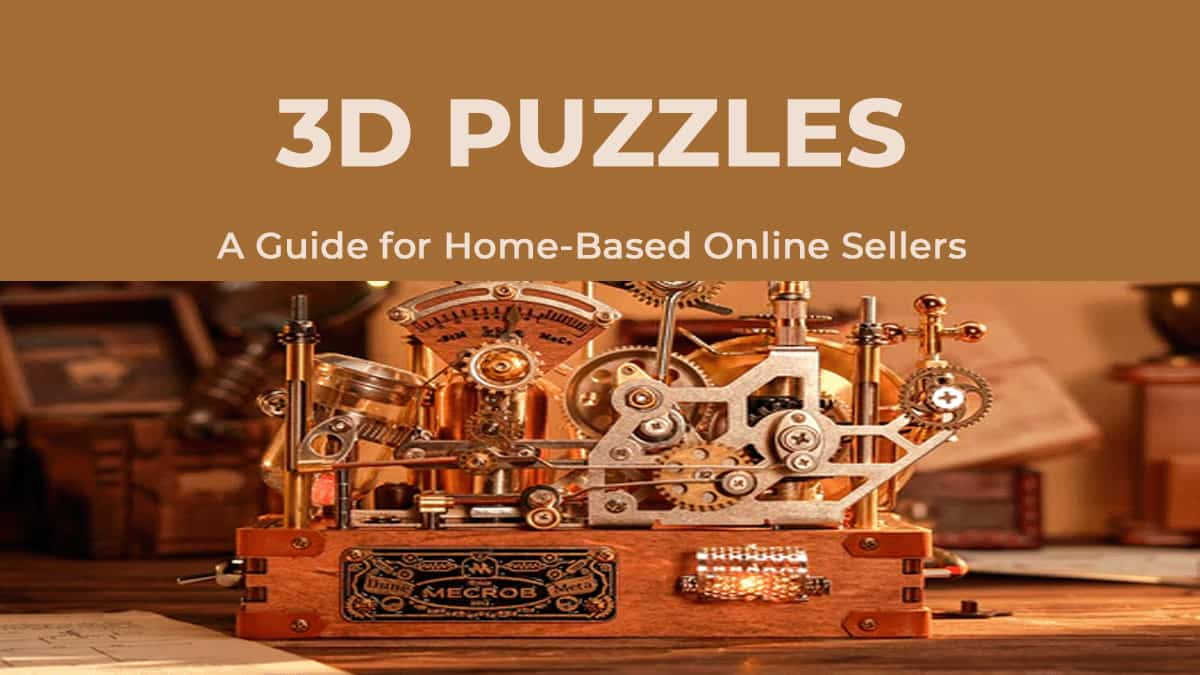
3D puzzles have become a modern favorite among families, educators, and hobbyists who crave hands-on challenges that double as décor or educational tools. These puzzles go far beyond the traditional jigsaw, transforming flat cardboard pieces into realistic models of landmarks, vehicles, animals, and architecture.
For home-based online sellers, this product line offers both visual appeal and educational value, making it a smart choice for ecommerce stores that focus on creativity, learning, or home entertainment.
Available through verified wholesalers at WorldwideBrands.com, which connects sellers to over 17 million products, 3D puzzles are easily sourced with low minimum orders and strong resale potential.
With the growing emphasis on screen-free family activities, sellers who build a niche store or product category around 3D puzzles can position themselves well for consistent year-round sales.
Market Snapshot: The Rise of 3D Puzzles
The global puzzle market reached an estimated $10.5 billion in 2025, with 3D puzzles accounting for a rapidly expanding segment that appeals to both kids and adults. Monthly global searches for the focus keyword 3D puzzles hover around 18,000 according to Google Trends, showing steady interest since 2022.
Toy retailers, Amazon, and educational outlets like Learning Resources report strong performance in 3D puzzle categories, especially those featuring recognizable landmarks or licensed brands like Harry Potter and Marvel.
The growing popularity of STEM education, homeschooling, and experiential gifts has driven even more buyers toward 3D puzzles as a form of enrichment. These products appeal to shoppers who want something more interactive than board games and more tangible than digital apps.
For sellers, this steady consumer interest combined with low product weight and compact packaging translates into manageable shipping and solid profit margins.
Target Demographic: Who’s Buying 3D Puzzles?
The primary market for 3D puzzles consists of adults aged 25–55, including parents, teachers, and hobbyists who appreciate the cognitive challenge and artistic display value.
Families purchase them as collaborative activities or gifts that encourage problem-solving and creativity in children aged 8–15. Many adult buyers are also motivated by stress relief and nostalgia, viewing puzzle assembly as a relaxing break from screen time.
These shoppers frequent Amazon, Walmart, and educational specialty sites but also follow DIY and crafting communities on YouTube, TikTok, and Pinterest. A secondary audience includes architecture and model enthusiasts who purchase high-end 3D puzzles as display pieces.
Sellers can target these audiences through SEO-driven product listings, social content showing finished models, and bundled offers that include accessories like display stands or LED lighting.
Demand and Competition Analysis for 3D Puzzles
Search trends indicate a steady upward climb in global demand for 3D puzzles, with minor spikes during the winter holidays and back-to-school season. Amazon and eBay feature thousands of listings, but many are from overseas manufacturers with inconsistent quality, which creates an opportunity for sellers who offer verified, premium puzzles sourced through legitimate wholesalers.
Amazon’s marketplace fees can cut into profits, averaging 15% per sale, while eBay’s structure appeals more to bargain hunters. Independent websites, on the other hand, allow higher margins and stronger branding potential through better product presentation and storytelling.
A home-based seller who highlights craftsmanship, durability, or eco-friendly materials can stand out easily in this niche. Unlike highly saturated toy categories, 3D puzzles reward sellers who curate carefully rather than compete solely on price.
Profit Margin Potential of 3D Puzzles
Wholesale pricing for 3D puzzles sourced through WorldwideBrands.com typically ranges from $6 to $15 for mid-range sets and up to $30 for large or specialty puzzles. Retail prices on Amazon and specialty stores generally fall between $20 and $60, depending on complexity, brand, and material (cardboard, wood, or metal).
A seller who purchases at $10 and retails at $35 can expect a gross margin near 70%. After accounting for platform fees and shipping, net margins typically settle around 35% on Amazon and 45 – 50% through independent ecommerce websites.
Profitability improves with bundled sets or themed collections, which allow slightly higher price points without additional shipping costs. Because the products are lightweight, fulfillment costs remain low – another reason they fit well in home-based ecommerce operations.
Year-Round Drawback of Selling 3D Puzzles
The main drawback of selling 3D puzzles is mild seasonality. Sales often dip by 15–20% in early spring and late summer, outside of gift-giving peaks and school holidays. However, these fluctuations are manageable with smart marketing. Sellers can maintain engagement through blog content or social media posts that show 3D puzzles as décor pieces or stress-relief tools rather than only toys or gifts.
Expanding into related product lines – such as puzzle glue, display cases, or lighting accessories – helps sustain interest during slower months. Another option is creating themed collections tied to current trends, like architectural landmarks or pop culture icons. These approaches not only flatten seasonal dips but also boost the store’s search relevance year-round.
Viability Verdict and Actionable Advice for 3D Puzzles
3D puzzles are a strong fit for home-based online sellers looking for affordable, educational, and visually appealing products with reliable global demand. They offer a balance of volume, variety, and margin potential that few toy categories match. With proper sourcing, branding, and customer engagement, sellers can turn a small niche into a sustainable long-term business.
Actionable Advice:
- Study top-performing listings on Amazon and educational retailers to understand keywords, photography, and customer expectations.
- Source verified suppliers through WorldwideBrands.com to avoid counterfeit or low-quality inventory.
- Use your own website to feature themed puzzle collections and upsell accessories like glue or display lights.
- Create simple tutorial videos showing puzzle assembly to attract both hobbyists and families on platforms like Pinterest and TikTok.
- Time promotions around gift-heavy periods such as November through January and educational restarts in August to capture peak sales.
For sellers seeking dependable margins and steady demand, 3D puzzles represent a high-potential product line that’s educational, giftable, and consistently profitable when sourced and marketed the right way.
